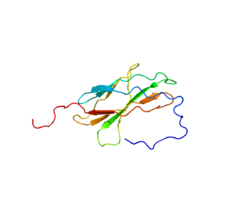
Deleted in Colorectal Cancer

2ED7, 2ED8, 2ED9, 2EDB, 2EDD, 2EDE, 3AU4, 4URT163013176ENSG00000187323ENSMUSG00000060534P43146P70211NM_005215NM_007831NP_005206NP_031857Deleted in Colorectal Carcinoma, also known as DCC, is a protein which in humans is encoded by the DCC gene. DCC has long been implicated in colorectal cancer. While the official, full name of this gene is Deleted in Colorectal Carcinoma, it is almost universally called Deleted in Colorectal Cancer. The protein product of DCC is a single transmembrane receptor also known as DCC, and it has the same interchangeable name. Deleted in Colorectal Carcinoma, also known as DCC, is a protein which in humans is encoded by the DCC gene. DCC has long been implicated in colorectal cancer. While the official, full name of this gene is Deleted in Colorectal Carcinoma, it is almost universally called Deleted in Colorectal Cancer. The protein product of DCC is a single transmembrane receptor also known as DCC, and it has the same interchangeable name. Since it was first discovered in a colorectal cancer study in 1990, DCC has been the focus of a significant amount of research. DCC held a controversial place as a tumour suppressor gene for many years, and is well known as an axon guidance receptor that responds to netrin-1. More recently DCC has been characterized as a dependence receptor, and many hypotheses have been put forward that have revived interest in DCC's candidacy as a tumour suppressor gene, as it may be a ligand-dependent suppressor that is frequently epigenetically silenced. Early studies of colorectal tumours found that allelic deletions of segments of chromosome 18q occur in a very high percentage of colorectal cancers. DCC was initially cloned out of the region and put forth as a putative tumour suppressor gene, though nothing was known about its function at the time. The DCC gene was examined for the genetic changes found with most other tumour suppressor genes, but it was found to have a comparatively low frequency of somatic mutation. Several years later DCC was shown to encode a transmembrane receptor protein that mediated the effects of netrin-1 on axon outgrowth. Soon after the protein product was confirmed, DCC knockout mice were created. As DCC−/− mutations are rapidly fatal due to a lack of nervous system development, DCC+/− mice were assessed for increased tumour development over two years, and no increase in tumour predisposition was detected. The discovery of a specific function for DCC that seemed to have little to do with cell cycle control, the low somatic mutation rate and the absence of cancer predisposition in DCC heterozygotes were fairly discouraging evidence for DCC's putative tumour suppressor status. This caused focus to shift to DCC's role in axon guidance for a time, until one study implicated DCC in regulation of cell death. As the 18q chromosomal deletions were never resolved to be related solely to another gene, DCC was rapidly reaccepted as a candidate. Recent research into the mechanisms of DCC signaling and in-vitro studies of DCC modifications have solidified DCC's tumour suppressor position, and have begun to integrate DCCs divergent functions as both an axon guidance molecule and a tumour suppressor into a single concept. The DCC gene is located at 18q21.3, and has a total of 57 possible exons and 43 possible introns. This theoretically results in 13 correctly sliced, putatively good proteins. The typical DCC protein has one signal peptide motif and eleven domains, including multiple immunoglobulin-like domains, a transmembrane domain, and several fibronectin type 3 domains. DCC has extracellular binding sites for both netrin-1 and heparin. Heparin sulphate is believed to also be present during neural growth as a type of co-factor for axon guidance. Intracellularly, DCC has been shown to have a caspase-3 proteolysis site at Asp 1290. DCC and neogenin, two of the netrin-1 receptors, have recently been shown to have sites for tyrosine phosphorylation (at Y1420 on DCC) and are likely interacting with Src family kinases in regulating responses to netrin-1.
